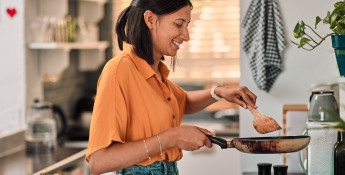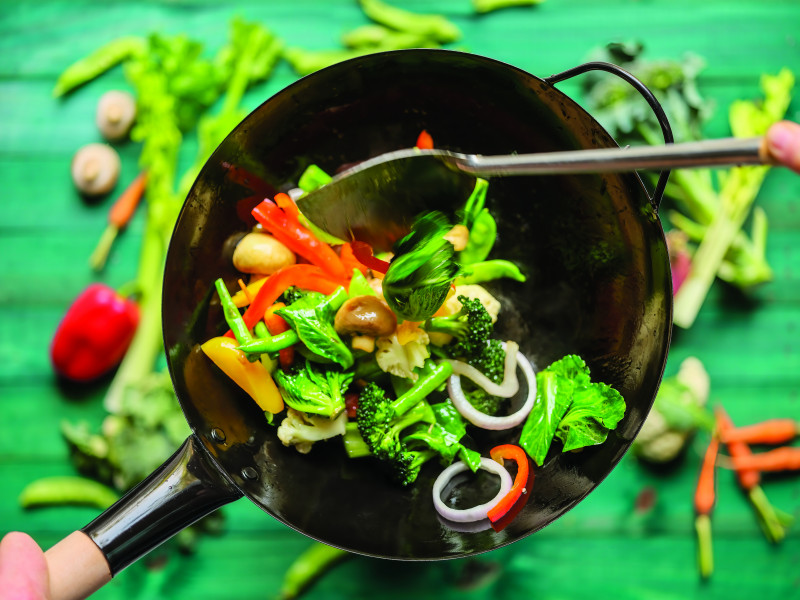By Sheridan Wimmer on August 14, 2020
How Different Cooking Methods Affect Nutrients

We all learn differently. Some of us are visual learners and we learn by seeing and remembering images clearly. Others are hands-on or kinesthetic learners, so experiential learning helps us retain information. And some of us learn by reading, writing or listening.
Just as our preferences in learning help us retain information better, some foods retain nutrients better depending on which cooking method we use.
“How you cook your meals can have a big impact on their nutritional content,” Karen Hanson, a registered dietitian, says. “Many vitamins and minerals in food are sensitive to heat, water, light and air exposure. The loss of nutrients increases with longer cooking times and higher temperatures.”
SOME LIKE IT HOT
Not all cooking methods have the same effects on all foods, and since we take sensory pleasure in eating, it’s important to consider what cooking does to flavor and texture. On the other hand, heat can damage certain vitamins in some food. It’s a fine balance.
ROASTING...
involves cooking your food in the oven, with or without added fat, at a temperature between 285 and 400 degrees. Roasting is often used with meats, fish, vegetables and eggs. Roasting damages vitamin C and most B-complex vitamins because of the heat, and vitamins A and E may also be destroyed if extra fat is added.
“Roasting is slightly less ideal for vegetables since the prolonged exposure to high heat can increase nutrient loss,” Hanson says. “If you like the taste of roasted vegetables, stick with hardier options that are more resistant to heat like beets, onions, potatoes, celery and green beans.”
SAUTÉING...
is a dry-heat method that usually requires a small amount of fat to keep food from sticking to the pan. It’s often used for vegetables and some types of tender or marinated meats. Very little fat is necessary, and the cooking time is shorter, so fewer nutrients are lost.
GRILLING OR BROILING...
involves cooking over charcoal, flames or heating elements with or without added fats. Heat-sensitive vitamins are lost but some fat is also lost as it drains out.
BAKING...
damages vitamin C and many of the B-complex vitamins, but what really makes or breaks baking as a healthy cooking method are the ingredients in your product.
“Baking meat, poultry and fish is a great way to preserve the proteins and other nutrients in these foods. One plus in baking is that it makes grains a little easier to digest, but it can also cause the formation of acrylamides in grains and potatoes,” Hanson says.
According to the FDA, acrylamide is a chemical that can form in some foods during high-temperature cooking. Remember, everything in moderation.
MICROWAVE ovens...
are often used to reheat leftovers, but they're also a good way to cook some vegetables. The microwave can be one of the best ways to retain vitamins and nutrients in vegetables.
“As a general rule, the best way to prevent nutrient loss is to cook vegetables quickly, with minimum heat and minimum liquid, and the microwave can accomplish this,” Hanson says.
COOKING WITH LIQUID (WATER, NOT WINE)
BOILING...
involves cooking food in hot water, broth, stock or other liquid. The effect of boiling on nutritional content varies depending on how long the foods are boiled.
“Veggies lose a lot of their vitamin C and B-complex vitamins, but the availability of some carotenoids may increase, at least in some vegetables,” Hanson says. “Some nutrients are leached into the water, however.”
BLANCHING...
is when you plunge food into boiling water for a short time. It is often the first step to preserving foods because it stops enzymes and helps veggies keep their bright colors. The nutrient loss is minimal because the cooking time is short. Blanching is one of the best ways to cook your vegetables because it’s quick and requires minimal heat and water.
STEAMING...
also uses liquid but the heat from the steam does the cooking. This method maintains watersoluble vitamins like folate, thiamine, riboflavin, niacin and more.
“Of all the cooking methods involving liquid, steaming appears to be best for nutrient retention,” Hanson says. “The hot steam cooks your food gently, which means valuable vitamins and minerals are preserved. You also don’t have to use fats or oils, which creates a healthier meal.”
FRYING WITH FAT
DEEP-FRYING...
is definitely a delicious cooking method. Since you’re fully submerging your food in hot oil, there’s no question frying increases the calorie count and fat content. That said, it doesn’t cause as much nutrient loss as boiling since the food cooks quickly.
STIR-FRYING...
uses a small amount of oil at a high temperature.
“Not much nutritional content is lost because of the high temperature,” Hanson says. “And since only a small amount of oil is used, stir-fried dishes can be both nutritious and low in calories.”
The cooking methods you choose are important for the texture and flavor of your foods but also affect the nutritional value. Choose methods that allow for less nutrient loss but don’t require the addition of large amounts of fat. No cooking method is perfect, so be sure to get an ample amount of fresh fruits and vegetables every day as part of a healthy, balanced diet.




